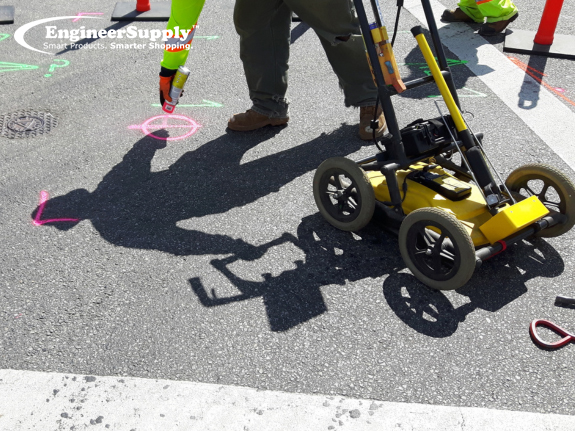
Steps on How To Use a Utility Locator
- Research and choose the right type of utility locator for your needs. Different types of utility locators are available in the market, such as electromagnetic locators (EMI), ground penetrating radar (GPR) units, and acoustic locators.
- Before starting, ensure that you have all the necessary safety equipment, such as personal protective gear and safety cones.
- Turn on the utility locator and select the appropriate frequency for the utility you want to locate.
- Walk slowly over the area you want to scan, holding the locator at arm's length and leveling it to the ground.
- Move the locator horizontally to scan the entire area in a back-and-forth motion.
- Pay attention to any visual or audio signals that indicate the presence of an underground utility line.
- If you find a utility line, mark it with paint or flags to indicate its location.
- Repeat the process until you have covered the entire area you need to scan.
- Finally, turn off the utility locator and store it in a safe place.
What is Utility Locating?
Utility locating is a process of using an underground utility locator to identify and mark underground utilities to prevent damage during excavation projects. It uses technologies such as ground-penetrating radar (GPR), electromagnetic detection, and utility maps to detect and locate underground utilities, including gas, water, electricity, and telecommunications lines. The goal of underground utility locators is to prevent accidental damage to these utilities and ensure the safety of workers and surrounding communities.
Importance of Utility Locating
Utility locating is essential for ensuring the safety of workers and the general public during excavation projects. Failure to locate and mark underground utilities can significantly damage infrastructure, cause service disruptions, and even accidents. The potential consequences of utility line damage are severe, including:
- Financial loss due to costly repairs
- Disruption of essential services, such as water, gas, electricity, and telecommunications
- Environmental damage due to leaks or spills
- Legal liabilities and fines.
Utility locating helps to prevent these issues by identifying the location of underground utilities before excavation work begins. This reduces the risk of damage to underground infrastructure and ensures that excavation activities proceed smoothly without service disruptions.

Process Involved in Utility Locating
The process of utility locating typically involves the following steps:
Site Preparation
Before starting the utility locating process, you must prepare the site. This includes marking the area's boundaries to be scanned and removing any debris or obstructions that might interfere with the scan.
Equipment Setup
Set up and calibrate the utility locator equipment according to the type of utility that you need to scan. The operator must also check all safety equipment and ensure it functions correctly.
Scanning
Scanning involves walking over the designated area with the utility locator and scanning for underground utilities. This is usually done in a systematic back-and-forth motion to ensure complete area coverage. The operator must carefully monitor the equipment for any signals indicating the presence of underground utilities.
Marking
Once you identify a utility, mark its location using paint, flags, or other suitable marking methods. The marking must be visible and indicate the location of the utility to prevent accidental damage during excavation work.
Reporting
After the scan, the operator must prepare a report outlining the findings. This report should include a detailed description of the identified utilities, locations, and other relevant information. Then, use the report to plan excavation work and ensure the process does not damage underground utilities.
Final Thoughts
Utility locating is a crucial process for ensuring the safety and efficiency of excavation projects. The accurate detection and marking of underground utilities can be achieved by utilizing a utility locator and employing advanced technologies. This helps protect vital infrastructure, prevent costly damages, and minimize service disruptions. When using a utility locator, it is important to follow established guidelines and safety protocols to maximize effectiveness and mitigate risks.
More Articles About Utility Locator